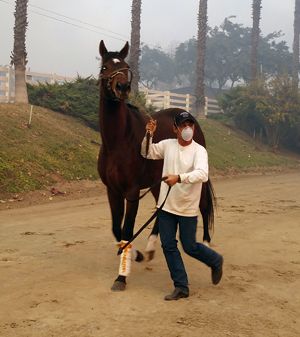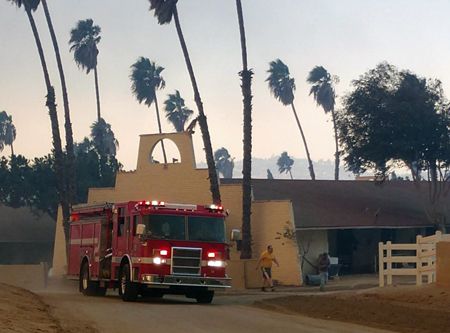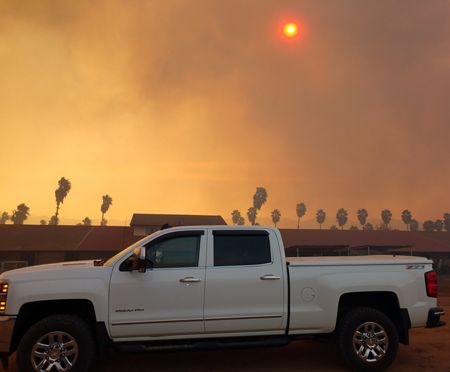Fire at San Luis Rey Training Center: A day of tragedy and heroism
Nearly 500 horses were on site when a California wildfire hit the property. Equine veterinarian Dr. Chuck Jenkins saw the disaster firsthandand helped save as many lives as possible.
The San Luis Rey Training Center is situated in a bucolic setting in Bonsall, California, in northern San Diego County. About 45 miles from Del Mar Thoroughbred Club, 95 miles from Santa Anita Park, and 75 miles from Los Alamitos Race Course, horses may ship from the training facility to those tracks the very same day.
Some magnificent racehorses, including Azeri and Cigar, have left their hoofprints on the San Luis Rey surface. Four Kentucky Derby winners began their early training there: Fusaichi Pegasus, Sunday Silence, Gato Del Sol and Ferdinand.
With stalls for 500 horses, mostly thoroughbred racehorses and their stable ponies, San Luis Rey features a one-mile training track, a smaller training surface and a few square miles of all-weather trails among rolling hills. The facility also includes automated mechanical walkers and a large equine exercise pool.
The San Luis Rey Training Center is open 365 days a year, enabling trainers to develop a permanent home or stable some horses when Santa Anita and Del Mar are full. During training hours, there are outriders, official clockers and an official gate crew on hand. It's the only auxiliary training track continuously approved by the California Horse Racing Board (CHRB) since its inception in 1984. All works are timed and published in the Daily Racing Form.
December 7, 2017: ‘I smell smoke!'

A horseman leads a horse to safety at San Luis Rey Training Center in Bonsall, California, on Dec. 7, 2017. All photos courtesy of Dr. Chuck Jenkins.The calm setting of the training center changed dramatically the morning of December 7, 2017.
Chuck Jenkins, DVM, who worked previously in private practice at Del Mar, Santa Anita and Los Alamitos, was filling in as a relief veterinarian at San Luis Rey that day for equine practitioner Ron Magrini, VMD. In the course of less than an hour, Dr. Jenkins' day quickly transformed from normal to tragic.
At about 11 a.m., the barn foreman came to Dr. Jenkins' veterinary truck with a list of horses needing attention. Dr. Jenkins mentioned to the foreman, “I smell smoke-do you?” As Dr. Jenkins proceeded to draw up medications, check on horses and do lameness exams, “sure enough we saw a large plume of smoke to the east of the training center,” he says.
The fire was located at the intersection of Interstate 15 and Highway 76, several miles from the training center-and it was moving directly toward them. Dr. Jenkins and the barn foreman decided it was time to evacuate the horses, and they began calling in emergency transport crews.
Unfortunately, with several wildfires in the vicinity, the highway patrol had closed the roads, allowing access only to first responders working to save homes and evacuate the Bonsall community. Even though several horse vans and trailers were close by, they were unable to get to the training center. And there were nearly 500 horses horses to evacuate.
The San Diego Sheriff's Department and facility security personnel began to order human evacuation of the training center. At that point some people left, but many stayed, committed to the care and safety of their horses-grooms, hotwalkers, exercise riders, assistant trainers, gallop girls, outriders, farriers and racetrack maintenance workers. “For those who hung tough at the training center assisting to save horses, it was a really heroic effort,” Dr. Jenkins says.
As the fires grew closer, Jehobany Catalan, an assistant to trainer Peter Miller, yelled over to Dr. Jenkins, “What do we do with the horses if the fire gets to the training center?”
“Just let them go-get them out of the stalls!” Dr. Jenkins yelled back.
“Do what?” Catalan countered.
“You just need to let them go!” Dr. Jenkins repeated.
“We've got millions of dollars' worth of horses here-some Breeders' Cup horses-how can we just let them go?” Catalan asked, incredulous.
“If you don't, we're going to have millions of dollars of dead horses here,” Dr. Jenkins responded. “We can't leave them in the barns!”
The fire originated from embers blown into a little canyon 200 to 300 yards from the training center property. “That's when we knew we were in trouble,” Dr. Jenkins says. “Once the fire started in the canyon, you could see the flames and black smoke raging throughout the area.” And when the Santa Ana winds accelerated from 20 mph to 50 to 60 mph, things quickly got worse.
The fire hits
When the wildfire reached the property, it immediately ignited several of the Mexican fan palm trees spread throughout the grounds. “The trees acted like tiki torches, the flames moving from tree to tree,” says Dr. Jenkins, who was working near a row of these trees. “As this happened, the large burning fronds fell onto the shedrows, igniting the dry hay and straw bedding, which exacerbated the spread of the fire from barn to barn.”
The blaze moved quickly through the training center, aided by the strong winds, and fire and smoke billowed everywhere. Though the horse stalls were metal-roofed and -sided, the barns were filled with combustible materials-dry hay, straw bedding and wood siding-and dry brush and grass surrounded the facility. The corrugated metal roofs became so hot that they in turn helped ignite the dry stall materials, eventually becoming twisted and tangled piles of wreckage.
At least a dozen fire trucks had arrived in the area, and two large helicopters were dropping water on houses in Bonsall. The choppers went back and forth to a large lake in the area, picking up water and then depositing it on the roaring fire. But since the priority was human safety and housing, the helicopters and fire trucks-with the exception of two trucks that arrived once the barns were already ablaze-did not assist the training facility.

With the majority of emergency fire crews assisting human safety efforts, just two fire trucks were available to battle the fire at San Luis Rey, which claimed the lives of 46 horses and destroyed nine barns.There were approximately 475 horses on site at San Luis Rey Downs when the fire broke out, and personnel did their best to get them all out of their stalls in time. The pandemonium of hundreds of panicked horses running in all different directions added to the chaos. And tragedy struck quickly.
“When the fire got on the grounds, it moved so fast that in one barn, 15 of the 40 horses didn't make it out of their stalls,” Dr. Jenkins says. “Sadly, they were totally charred in a matter of minutes.”
Another barn had just received a delivery of 200 bales of dry grass a day or two earlier. “Once that caught on fire, it was basically like a flame thrower,” Dr. Jenkins notes. “The flames and burning hay blew down the shedrow of that barn and within a few minutes engulfed it completely.”
Dr. Jenkins was working near a building that contained 80 horses, and with the crew of grooms, hot walkers, exercise riders, barn staff and other able-bodied hands, they were able to lead all the horses out to safety. It took just 10 minutes for the fire to reach Dr. Jenkins' truck once it hit the grounds. Fortunately he was able to move it to a safe area before it ignited.
Hugo Lara, head of security for the San Luis Rey Training Center, says the center's maintenance department fought the fire the best they could. As soon as possible they had their water trucks spraying water, but the fire spread too fast, the effort hampered by the excessive winds, the volume of dry combustible material and the need to rescue the horses. Lara guesses that it took just a few minutes from the time the palm fronds ignited the barns until the entire facility was a devastating inferno.
In total, nine barns were destroyed by the fire. Some barns waited too late to take action, and while staff tried their best, fighting the fire with garden hoses, many of those horses succumbed to the fire. Others had to be euthanized later because of their injuries. Two horses that had been seen running continuously around the one-mile track were found dead, having apparently run themselves to death. The CHRB has reported that 46 horses died as a result of the fire.
Triage, suturing, treating burns
While there are two veterinary practices that operate full time at San Luis Rey Training Center, Dr. Jenkins was the only practitioner on site when the fire hit.
“When the flame and smoke were at their most intense, there wasn't much I could do,” he says. “I moved my truck over to an area where tractors and other heavy equipment were stored, out of the way of the burning barns. I had to just basically sit there. I tried to get out of my truck a few times, but then 40 to 50 horses would go running by in a herd. So if I got out of my truck I was going to die of smoke inhalation, burn by fire, or get trampled by horses. I just had to wait until things calmed down a bit so we could start actually gathering the horses up and getting them to a safe place.”

Dr. Chuck Jenkins was able to move his veterinary truck to relative safety before it was engulfed by flames.Michael Manno, DVM, of San Deiguito Equine Group based at San Luis Rey, had gone home that day because his house was in the direction of the fire and he needed to evacuate his horses. When he called at 11:30 and asked if he needed to get back to the training center, Dr. Jenkins said yes-he desperately needed help. Luckily Dr. Manno knew the back roads and was able to get there quickly with his associate Brett Robinson, DVM. Korin Potenza, DVM, CVA, and her husband, Nick Huggons, DVM, DACVS, of the Trifecta Equine Athletic Center and San Luis Rey Equine Hospital, soon arrived to join the efforts.
Once the fire was under control, the triage could begin. Drs. Potenza and Huggons evacuated about 100 horses to their veterinary facilities to treat the most critical injuries and to get uninjured animals into safe housing. About 20 of those horses needed care for burns, wounds or other injuries. Treatments included fluids, suturing and time in the hyperbaric chamber.
Meanwhile, at San Luis Rey, Dr. Jenkins and colleagues treated injuries on site. The first step was to corral the horses, then identify which ones needed immediate attention and treat them one by one. A few horses needed to be euthanized. One had a broken leg, many had been burned, and others had lacerations and scratches. Doctors provided suturing, bandaging, intravenous fluids, tranquilizers and other care depending on the injury. “There were no veterinary technicians on the grounds,” Dr. Jenkins notes. “Whoever happened to be holding a horse would assist the veterinarian.”
One tragic image haunts Dr. Jenkins. “A horse ran right by me fully engulfed in fire,” he says. “In retrospect, I realize it came from that barn where the horses died before they could be evacuated from their stalls. What apparently happened was this horse's stall bedding caught on fire, which he became engulfed in. Though he was running wild, his burns were too severe to save him, and I had to euthanize him.”
The majority of the injuries were lacerations and scrapes resulting from the horses running free at full speed through shedrows and equipment, Dr. Jenkins says. “Some horses we immediately triaged, but the main effort was to get the horses on trailers and vans and get them out to Del Mar and other smaller facilities,” he says.
Most of the trailers did not arrive till about 5 p.m., as the highway patrol continued to prevent them from getting through. So the practitioners who made it to San Luis Rey were “a godsend,” Dr. Jenkins says. Even the veterinarian Dr. Jenkins was filling in for, Dr. Magrini, left his meeting to assist at the training center by early afternoon.
When Dr. Jenkins left the facility at 11 p.m., the last few horses were being loaded onto vans and trailers to be hauled away. Most were taken to Del Mar, some went to smaller facilities and some even went to private backyards. That night there were no live horses left on the grounds. When Dr. Jenkins left San Luis Rey, all that needed to be done was completed, though the largest bedding pile outside one of the barns was still smoldering almost 12 hours later.
Aftermath
As of December 13, 2017, the total count was 46 dead horses and one or two horses unaccounted for of the approximately 475 total horses at the facility, according to the CHRB. Those individuals who stayed to save the lives of more than 400 horses were not unscathed either-some were injured, some experienced smoke inhalation and some were hospitalized for other injuries.
The facility is considering putting up temporary barns, then eventually rebuilding all of the training facility that was lost, including about 200 stalls.
Treatment continues at area equine facilities to heal horses injured as a result of the fire. The people who assisted with rescue, evacuation and treatment efforts-including the veterinarians who worked themselves to exhaustion and beyond-are the true heroes of the day.
Ed Kane, PhD, is a researcher and consultant in animal nutrition. He is an author and editor on nutrition, physiology and veterinary medicine with a background in horses, pets and livestock.








